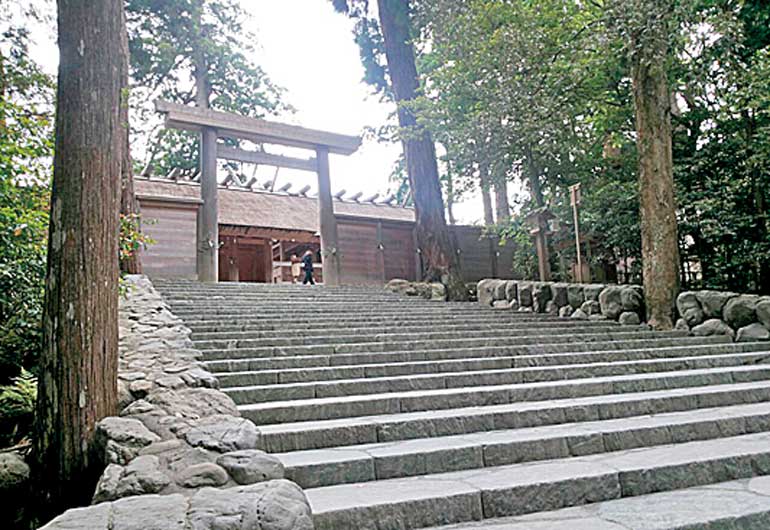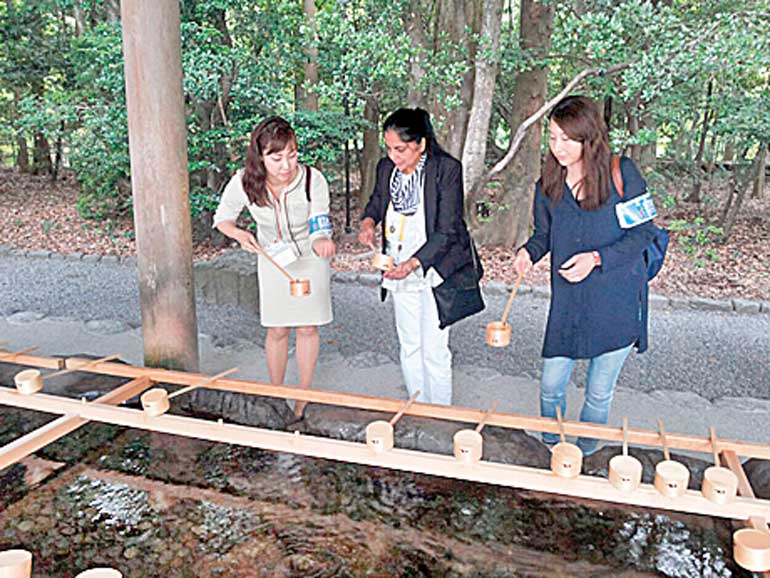Friday Dec 26, 2025
Friday Dec 26, 2025
Monday, 6 June 2016 00:17 - - {{hitsCtrl.values.hits}}

Stairs leading to the Jingu Shrine sacred area, from which point onwards photography is disallowed

Shops outside on the way to the Shrine

Three Cyprus plants, planted by the G 7 leaders before the Summit commenced.

Special constructions for the storage of rice, for festivals.

A pond at which one is cleansed before proceeding to the Shrine area
 With the 42ndG 7 summit underway last week,an army of journalists, (the Media Centre authorities revealed the registered number being six thousand) from around the world along with the leaders of 15 countries descended on Japan’s Ise Shima region- a place known as the spiritual heart of Japan.
With the 42ndG 7 summit underway last week,an army of journalists, (the Media Centre authorities revealed the registered number being six thousand) from around the world along with the leaders of 15 countries descended on Japan’s Ise Shima region- a place known as the spiritual heart of Japan.
They have one major place to visit before start of business that is the Ise Grand Shrine.
Ise Shima is the home of Japan’s most revered Shinto Shrine, Ise Jingu, known also as the Ise Grand Shrine, dedicated to the sun goddess of Amaterasu Omikami, the predecessor of the Imperial family, supreme deity of Shinto venerated by many Japanese.
Followers of Shintoism believe that everything – rocks, fire, trees, and the sky - has its own spirit of God.
The Ise Grand Shrine or Ise Jingu is considered as the foundation of Japanese spirituality, dating back to almost 2000 years, is a shrine complex composed of a larger number of Shinto shrines centered on two main shrines, Naiku which is dedicated to Amaterasu Omikami and Geku, dedicated to Yoyouke, an agricultural goddess who was summoned from the North of Kyoto Prefecture and enshrined at Ise about 1,500 years ago.
Japan’s Prime Minister Abe guided his G 7 colleagues to this unique site Ise-Jingu, Shrine on the morning before the G 7 sessions kicked off, showcasing Japan’s rich traditions to the world. He had earlier declared it a good place for G-7 leaders to feel the “spiritual nature of Japan” and “understand the spirituality of the Japanese people”.The journalists followed suit, mesmerised by its serene environs and the extent of the place as that of the size of the capitol of France, Paris!
The G7 leaders were also welcomed by 46 children from kindergartens affiliated with Ise Jingu. For the tree-planting ceremony with Eikei Suzuki, the Governor of Mie, 20 local elementary school students participated
Japan has strategically made Ise the venue for the International Media Centre that housed the International journalists for coverage of the G 7 summit just two bus stops before the Jingu Shrine, although the Summit proper was located in Kashikojima Island, a scenic island in Ago Bay within the city of Shima, Mie Prefecture, famous for Japanese pearl farming which began in 1893 and remains a major production area today.
The weather was perfect on the morning the Shrine was to receive this sudden influx of invitees from overseas. My Japanese colleagues, accompanying me, walking on either side of me, were Kayoko Inagaki and Sayuri Ito from the Ise Press Centre, specially set up by Ise City for the Summit to assist the media personnel who enter through the Ise train station. I noted the pleasant cool breeze that brushed past us as we set off on our trek to view Ise Jingu which sits as the crown jewel of the many cultural sites of the Ise Shimaa region in South-eastern Mie.
On the way Kayoko, also a specialist in Public Relations from Tokyo, amazingly very fluent in English, gave me the information that she knows and translated also what the other said. More than 1.500 rituals take place each year at the Shrine, visited by approximately 10 million Japanese alone, annually thus far. They pray for the prosperity of the Imperial family, for world peace and bountiful harvests.
It is customary she says for the Prime Minister and the Minister of Agriculture, Forestry and Fisheries to visit Ise Jingu on the first working day of the year, typically 4th January unless it happens to fall on a weekend.
Goddess Amaterasu Omikami was originally worshipped in the Imperial Palace by successive Emperors of Japan. However during the reign of the 10th Emperor, Sujin the sacred mirror (the symbol of Amaterasu Omikami) was removed from the Imperial Palace. Then during the reign of the 11thEmperor Suinin, he ordered his daughter, Princess Yamato-hime, to seek the most appropriate place to permanently enshrine and worship Ameterasu Omikami.
After searching across many regions about 2000 years ago, the Princess finally received a revelation that Amaterasu Omikami should be enshrined and worshipped eternally in Ise.
Since then Ise Jingu has been considered the nation’s most revered Shinto site.
Three Cyprus trees planted by the G7 leaders
Once you get to the imposing Uji-bashi Bridge at the entrance, you bow twice as a mark of respect before crossing, a ritual you repeat on the return too. About 1000 meters in, is the area at which the G 7 leaders, a few hours before us, had planted 3 Cyprus trees to commemorate their visit.
Before you reach the shrine area there is a natural stream of water, at which in the early days pilgrims would wash their hands face and feet before entering the shrine area. Now a separate place with water is placed for the washing of the hands and mouth. Even for this, there is a special ritual followed.
There is also a separate area that houses the horses that parade during festivals and separate store houses for rice. The shrine employees 600 people and hosts around 1,500 festivals and rituals throughout the year.
Re-building of the shrine every 20 years!
Of the rituals taking place at Isu Jingu, Shikinen Sengu is the biggest event.
Shikinen Sengu refers to the periodic rebuilding of the Shrine says Sayuri Ito, of the Ise Press Centre who’s hometown is Ise, explaining in detail:
“Every 20 years, an identical divine palace with the same dimensions as the current one is constructed at the site adjacent to the main sanctuary, the sacred costumes, furnishings and divine treasures to be placed inside the sacred palace are also remade. Once they are prepared the priests move the Holy Mirror to the new sanctuary. The whole process is called Shikinen Sengu” she explained
Shikinen Sengu comes from the Japanese traditional concept of Tokowaka or eternally young. It is a custom of keeping things clean and fresh in an idea of revival of spirit and new energy, eternity of mankind and universality of the universe. The 20 year cycle of time was established approximately 1,300 years ago by Emperor Tenmu. Although its exact basis is unclear, the time span is considered reasonable in terms of passing on construction techniques to the next generations and the durability of shrine structures.
“It takes about eight years to conduct all the rituals and events needed for Shikinen rituals and events needed for Shikinen Sengu”, she added.
Both Naiku and Geku have adjacent plots of land facing East and West that are the same size. During the Shikinen Shengu both Shrines are destroyed and rebuilt on the opposite plots. Circular pillars are buried deep in the ground and a thatched roof is made for the top of each new structure.
The first Shikinen Sengu Naiku was conducted in 690, under the reign of the 41st Emperor Jito. The last Shikinen Shengu, conducted- the 62ndwas in 2013.
The Sengukan Museum
To commemorate the 62nd Shikinen Sengu, Ise Jingu established the Sengukan Museum, located on the Geku premises. The Museum, which features a mixture of modern and traditional architecture, has exhibits demonstrating the craftsmanship and spirit passed down to generations via Shikinen Sengu.
It also houses the Sengu Theatre and educational material for visitors to learn about IseJingu, Shikinen Sengu and Shintoism and it holds workshops and other events.
In addition, at the Sanshuden (a rest house), as was done by the G7 leaders we had a chance to watch images of Ise Jingu on 8K Super Hi-Vision TV which is equipped with Japan’s latest technologies.
It was indeed a journey down the ages of Japanese rich culture and an afternoon well spent in the beautiful and tranquil settings of the lush nature surroundings that envelop the sacred spirit.
The three of us women, and another from Ise Press centre, Kaori Takakuwa, also felt like celebrities as the entire spiritual journey from the entrance back to the vehicle park was video filmed by a videographer Eri Kakihara attached to the production company of Nippon Television AX- ON- one of Japan’s national TV.
It was also subject to a refreshing change from the usual, usually in my profession it is I who do the interviewing, but this time the tables turned and many Japan’s journalists asked the questions, views on my visit of Ise and the Shrine and recorded same for the Japanese public through TV and the newspapers. So efficient was NHK World that they even sent me the link no sooner they telecasted the interview they did of me at the International Media centre.
Judging by the system in which the Japanese have conducted the promotions of the earlier little or virtually unknown Ise Shima region, and of the Jingu Shrine an attraction no doubt that all visitors of the G7 gathered here will remember of Ise, and the Ise city, many more visitors from all over the world are bound to be added on to that annual 10 million Japanese in number that gather here as pilgrims to the shrine, in the years to come.
That is sure as sunrise for these folks in the ‘land of the rising sun’…